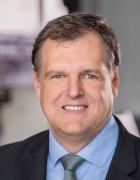
Prof. Dr. Wolfram Volk
Academic Career and Research Areas
Prof. Volk’s (b. 1968) research explores the fields of metal forming and casting. For forming technology, the focus is on the second stage of transforming semifinished products to finished components, in particular for sheet forming. The further development of simulation methods is also examined. As regards casting, the focus of his research is on continuous casting of light metals and copper base alloys and ways to create and work with composite casting.
Prof. Volk studied physics and then mechanics at Darmstadt University of Technology, graduating in 1994. He obtained his doctorate (1999) under Prof. Dr.-Ing. Wolfgang Ehlers at the University of Stuttgart’s Institute of Mechanics. After that, Prof. Volk joined BMW AG in Munich. He held several positions in the department of forming technology, focusing on forming simulation, product and process planning and concept development. Prof. Volk has held the Chair of Metal Forming and Casting since April 1st, 2011.
Key Publications (all publications)
Norz, R.; Vitzthum, S.; Volk, W. Failure behaviour of various pre-formed steel sheets with respect to the mechanical grain boundary properties. International Journal of Material Forming 15 (4), 2022.
AbstractGreß, T., Glück Nardi, V., Schmid, S., Hoyer, J., Rizaiev, Y., Boll, T., Seils, S., Tonn, B., Volk, W. Vertical continuous compound casting of copper aluminum bilayer rods (2021) Journal of Materials Processing Technology, 288, art. no. 116854.
AbstractVolk, W, Norz, R., Eder, M., Hoffmann, H. Influence of non-proportional load paths and change in loading direction on the failure mode of sheet metals (2020) CIRP Annals, 69 (1), pp. 273-276.
AbstractVolk, W., Groche, P., Brosius, A., Ghiotti, A., Kinsey, B.L., Liewald, M., Madej, L., Min, J., Yanagimoto, J. Models and modelling for process limits in metal forming (2019) CIRP Annals, 68 (2), pp. 775-798.
AbstractVolk, W., Hora P. New algorithm for a robust user-independent evaluation of beginning instability for the experimental FLC determination (2011) International Journal of Material Forming 4 (3), pp. 339-346.
AbstractIf you wish your profile to be changed or updated please contact Franz Langer.